than any other country in the world*
Stop ISRAELI WAR CRIMES and GENOCIDE

|
ISRAEL MURDERED MORE CHILDREN
than any other country in the world* Stop ISRAELI WAR CRIMES and GENOCIDE Your Seeds Source...
| ||
| ||
Laguna del Maule is a high altitude lake at about 2100 meters. This may not sound very high for the northern parts of Chile, but for central-southern parts it is indeed very high, and the area around lake receives a lot of snow in winter, sometimes several meters high (the annual rainfall is around 1000 – 1500 mm., concentrated in winter). The lake is located very far east, so that it does not receive the full brunt of wet fronts coming from Pacific ocean, which discharge their humidity over the mountain ranges nearer to the central part, like Vilches, but still it gets considerable precipitations, and the snow may linger up to December (up to 8 months during a snowy winter!).
The Laguna Maule can be easily reached from Talca or, if you come from Santiago, you can take a shorter route, getting off at Molina and taking the road to Cumpeo and further. This will shave off about 40 kilometers. From Talca you have excellent paved road for about 100 kilometers, and then another 40 km. of dirt road to the lake and 60 km. to the Argentinean border. Recently, in 2008 that part of dirt road was improved, so that it is possible to reach the lake in just two hours.
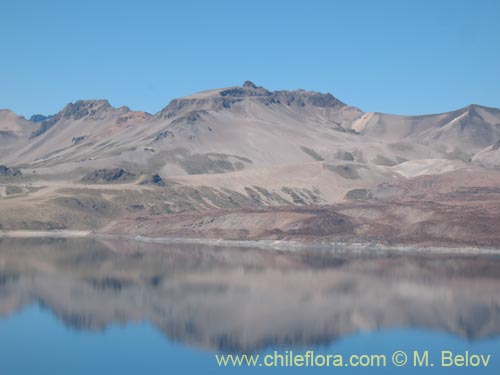
However to get to know all the vegetation types and to see most of the plants, you may need several days. The description of the route below presents the best hot spots for plant watching, but bear in mind that to fully see all of it you would need certainly at least three days, and unfortunately there are no hotels in the area (closest place to stay overnight would be about 70 kilometers from Talca and 70 kilometers from Laguna del Maule).
One can divide the trip into several parts, with the main reference points being Currilinque bridge (km. 95 from Talca), first border check-point La Mina (km. 100), Cuesta Los Condores (km. 130), second check-point at the Laguna del Maule Dam (km. 140) and finally the Argentinean border at km. 156.
The first part of the route to Laguna Maule scenically is not extremely exciting. At 40 km. you will pass the Colbun Dam constructed some 20 years go and which created a special microclimate around it, both making it more humid and less cold, so that in nearby mountains, almost inaccessible from the road, one can find enormous quantities of copihues (Lapageria rosea), not so common in other interior areas here. Along the road you will find Escallonias, Gevuina avellana, Lobelia tupa, and also Bromeliaceae, especially Puya berteroniana and the less frequent Ochagavia carnea. The latter one can be found on the rocky steep slopes near the end of the lake and also past it. Its fruits are sweet and edible and can be collected around February. Among the species which deserve special mention there are Tropaeolum ciliatum and Viola portalesia.
There are two interesting spots to visit along the paved road, the first at about 90 km. from Talca, where the Curilinque bridge crosses the Maule river, and the second spot is some five kilometers further along the paved road.
At the second spot you will two both puyas (Puya berteroniana, Puya coerulea var. monteroana) which grow in the mountain areas, Cistanthe grandiflora, several calceolarias,
Just a few kilometers after the end of the paved road there is a customs and border check-point. Please note that as a foreigner you need usually a permit to enter the border zones, and this permit should be obtained three months in advance. If you head to Argentina, or simply pretend to do so, you do not need to have this permit, because this is an official border crossing.
Beginning after another 5 kilometers or so from the checkpoint watch out for the Austrocedrus chilensis trees which tend to form here and there sparse woods.
The road goes along the floor of a valley, crossing two bridges at about 10 and 20 kilometers from the checkpoint; all this area has several interesting species, like Ephedra chilensis, Solanum ligustrinum, Mutisia spinosa, somewhat less frequent Mutisia decurrens and Mutisia subulata, Colletia spinosa, Colliguaja salicifolia, Berberis microphylla, and the very common Chuquiraga oppositifolia, a beautiful shrub with yellow flowers which turn white when the seeds are ripe – that is the reason why it is called hierba blanca, white grass in Spanish. On most of the ephedra and colletia plants one will almost certainly find Tristerix verticillatus, a parasite plant which has long red flowers and orange fruits which have medicinal properties, a real beauty when blooming.
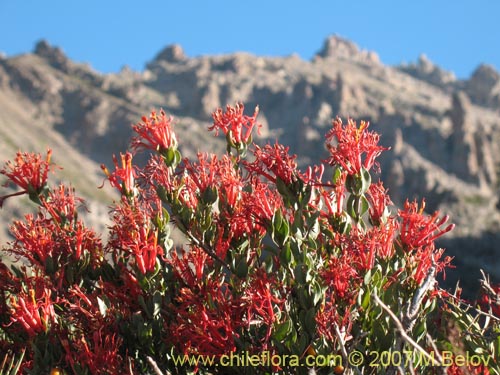
Cuesta Los Condores is a long, steady climb of about 5 kilometers, all along which Mimulus luteus will dominate the road sides; half-way through on the left side there is relatively flat field well worth checking out, because on a 300 x 300 m it concentrates enormous species diversity. There are many beautiful species, from which one can single out Alstroemeria exerens, Rhodophiala montana, both of which find here their lower altitudinal limit of distribution, Senna arnottiana, considered to be rare in the 7th Region, Azara alpina, easy to spot due to red berries, Ephedra chilensis, Berberis empetrifolia and Berberis montana, which have blue edible fruits. The latter species can be found near water, and Berberis emeptrifolia prefers drier spots. The two brooks which cross the field attract other hydrophile plants, like Calceolaria arachnoidea, Ribes cucullatum, Senecio fistulosus, the latter being a medicinal plant.
The most interesting shrub plant there is Orites myrtoidea and can be found in the rocks some 400 meters from the road. It is considered to be endangered, and it is surprising to see how it manages to grow on the seemingly solid rock. Viola volcanica also grows nearby in sand fields and blooms around December. If you are very lucky, you can spot the beautiful, but fleeting blue Solenomelus segethii flowers: they last only one or two days.
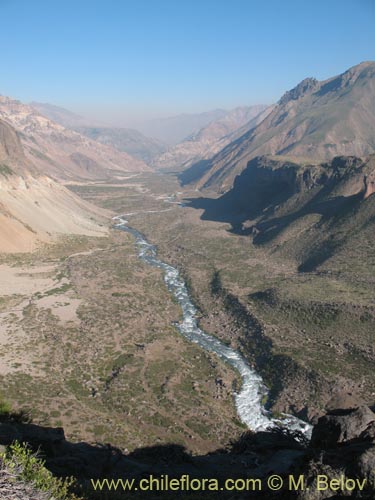
At the end of the climb one drives into a completely flat sandy field about 1 km. long which is full of orange orchids (Chloraea alpina) and yellow Rhodophiala montana, a sight difficult to forget. From here the vegetation is more or less similar, but if you have time to spare, you can try going left (almost at the end of that flat field, there is road going down towards the main river, about 2 kilometers). This roads can be done in a small, low car. If you are driving a front-wheel drive car and get stuck on your way back (there is a short, but steep climb), just turn around and drive backwards – this will put more weight on the front wheels and will allow you to clear the obstacle without any hassle.
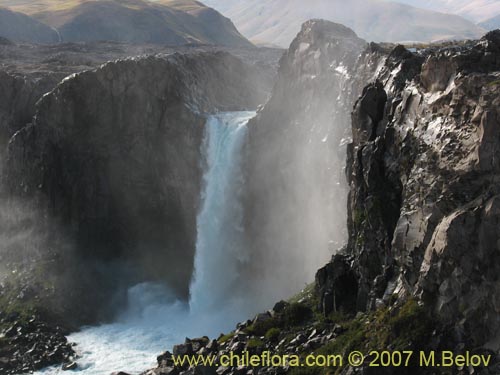
Last stretch of the road to the second check-point is cut out in the rock, and has slighly different species set-up. At one point you will see on the left side of the road pine trees (the only ones for many kilometers here), and you should concentrate your attention at the stretch just before and after that reference point (about 1 kilometer either way), with all plants visilbe from the car.

Before you reach the pine trees, very prominent are Schizanthus grahamii, Mutisia linearifolia, and Alstroemeria exerens. There are also two species of very similar Fabaceae, one being the beautiful Lathyrus subandinus and the other I have not been able to identify so far. Vicia magnifolia with white flowers also grows in many places there, covering completely some slopes. There is a small “vegas” area where one can find Geum magellanicum, Calceolaria filicaulis ssp. filicaulis, Senecio fistulosus, Escallonia virgata. Two species of Berberis also are present there. If you look carefully just at the side of the road to your right you may spot the very rare endemic calceolaria species which grows only in the vicinity of the Laguna Maule - Calceolaria pallida.
Just 1 kilometer after passing the pine trees one can see Calceolaria cavanillesii (near running water) and here and there strange-looking plants of Nasthanthus spathulatus and the stinging Caiophora prietea.
After reaching the second check-point, you will almost immediately see the lake. The vegetation here is very similar along all the route bordering the lake, so it is difficult to give special indications as to what to see where.
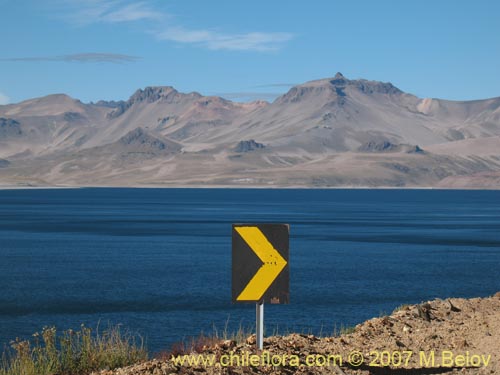
Most interesting species which grow in most parts along the route are Viola cotyledon, Nassauvia revoluta and two more Nassauvia species, the medicinal Adesmia emarginata, Sisyrinchium junceum ssp. colchaguense, Loasa filicifolia, and Pozoa coriacea, Chiliotrichum rosmarinifolium, Oreopolus glacialis, Calceolaria filicaulis ssp. filicaulis, Mimulus cupreus. Just about one kilometer from the lake dam you can find another population of Caiophora prietea on your left, and further on you can check the vegas (High Andean swamps) vegetation in several places, finding there plants like Silene chilensis, Ranunculus, Gaultheria caespitosa, Calceolaria filicaulis ssp. filicaulis. If you are very persistent and lucky, you may find an occasional population of Pinguicula chilensis, a small plant the flower of which resembles that of violas, and which is insectivorous. It grows in damp areas near brooks.
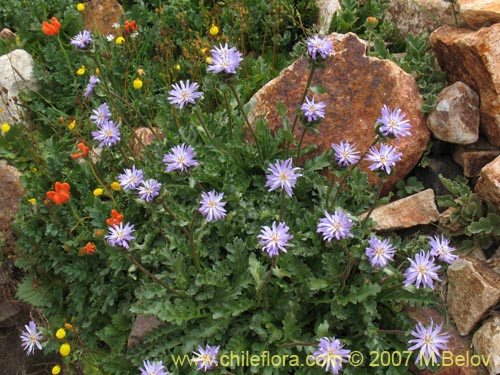
Another special plant is Empetrum rubrum, a species usually found much further south in Chile, but which has an enclave here, surviving since the last Ice Age. In a deep ravine on the left there is also a very big population of Loasa lateritia which, unlike most species of Loasacaeae does not have stingy leaves, and is extremely ornamental due to the big red flowers which are very difficult to miss when the plant blooms. When you almost reach the end of the lake, the road gives a long detour around the bay which is a preferred spot for recreational fishermen and there is a small, but dense population of yellow Euphrasia andicola worth a short stop.
The road passes a shack at the end of the lake where a few plants of Araucaria araucana were planted (very laudable), unfortunately the people keep a lot of livestock which decimates the native plants all around that place (not so laudable at all). In general one must say that the shepherds here are extremely ignorant about the the protection of wildlife and plants, and especially one custom is very dangerous – to burn off woody shrub areas to replace them with pasture-type vegetation, like Stipa. Fortunately, it is rather difficult to set the vegetation on fire, so only small patches suffer every year here and there. But I have seen areas where more interesting and rare plants suffered heavily this intervention. One might think that such plants like Alstroemerias may recover easily next year – finally their main organs are hidden well below the ground, but this is not the case. One field of Alstroemeria exersens was completely burned down one season. Next season I have observed only about 10 % of plants. Now, in 2009 it is already two years since the incident, and still no more plants are to be seen. It remains to be seen whether this damage is permanent and how many years it will take for this population to recover. These barbaric practices must stop, but the authorities are helpless (or do not care). Although in Chile there is a law which provides imprisionment for those who set fire (even unintentionally), it is never applied even in more populated areas, so here in the wilderness it is non-existent.
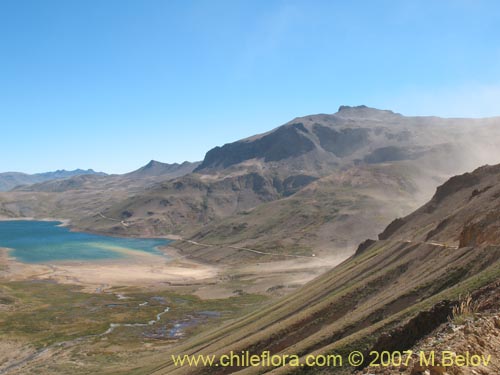
The road continues on to the Argentinian border (about 8 km. from the end of the lake), and this part is also extremely interesting, because the vegetation changes to higher altitude plant species. It is impossible to mention all the areas and species, but look out for the delicate Oxalis adenophylla fields very close to the border and Calandrinia affinis. Also very interesting place to check out if driving a small car is the “vega” just at the border, when you arrive at the border, look left, you will see a flat area with high posts and then some 300 meters further there are green spots. There are at least 25 species there!
If you are driving 4-wheel drive vehicle, you might as well consider some adventure and drive up to the Cari-launa Lake just above the border at 3000 m (See the article on Trip to the Cari-Launa Lake).
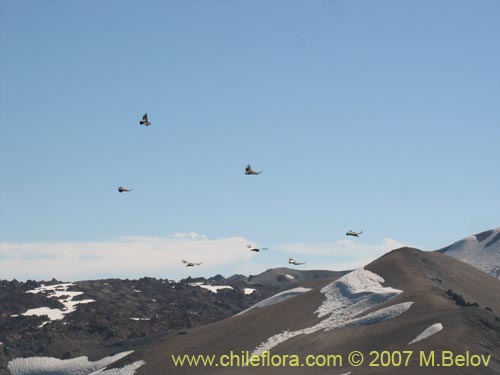
Adiantum chilense var. chilense
Alstroemeria ligtu ssp. incarnata
Calceolaria corymbosa ssp. mimuloides
Calceolaria filicaulis ssp. filicaulis
Ranunculus peduncularis var. erodiifolius
Sisyrinchium junceum ssp. junceum
Sisyrinchium junceum ssp. colchaguense